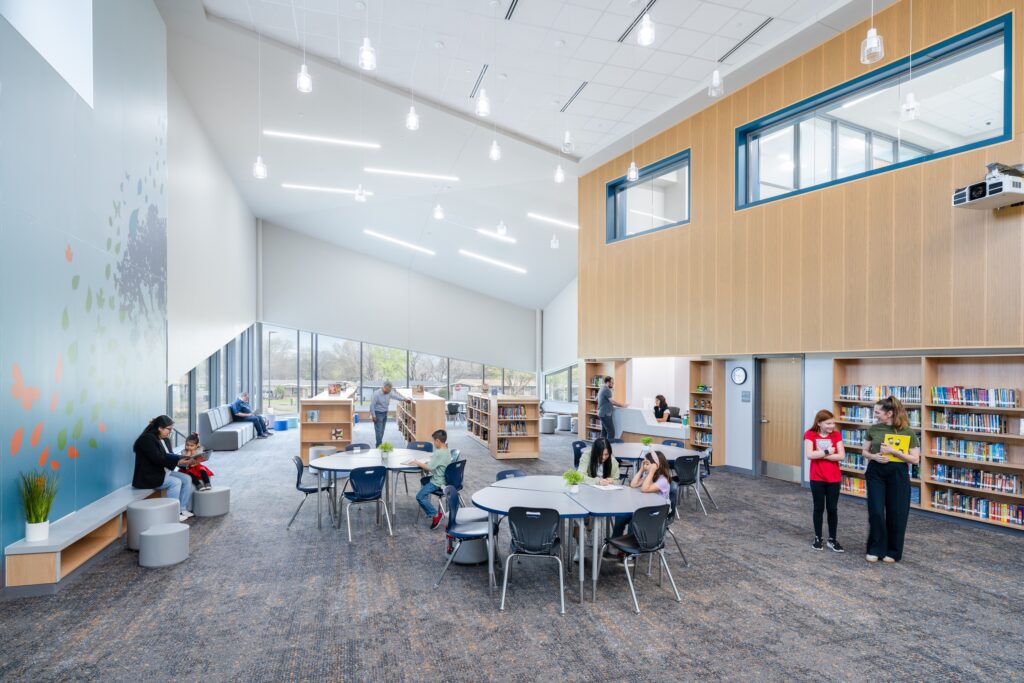In 2018, nearly half of U.S. students in grades 5 to 12 said they felt disengaged at school. Imagine a science lab where two students eagerly lean over an experiment, tinkering with equipment and asking each other questions, while their group members sit back, watching from the sidelines. What looks like a small moment ripples outward, with disengaged students experiencing less collaboration, fewer chances to practice problem-solving, and a lost opportunity to think about how what they are learning connects to the real world.
Engagement can take many forms, from paying attention and taking part in classroom activities, to feeling supported by teachers, to thinking about how lessons connect with experiences outside of school. What we know for sure is that engaged students consistently show greater academic success and well-being than students who are disengaged. This raises urgent questions about what it means for students to be engaged and how schools can foster it. The challenge for designers and educators has been how to foster engagement and measure this wide-reaching outcome, particularly in the context of K-12 schools. With so many competing visions of what schools should accomplish, the field has lacked clear, shared ways to connect design decisions to student engagement, and this has slowed both research and practice.

The Coalition for the Advanced Understanding of School Environments (CAUSE) has partnered with EDmarket to set shared foundations for measuring design impacts. Since our introduction in 2024, we have been building a framework and a set of survey tools that are freely available to anyone. The CAUSE survey tools ask about the fundamentals of how students and teachers experience their environments, including lighting, acoustics, and safety. They also ask about a small group of high-priority human outcomes with strong research histories, validated measures, and documented links to student learning and well-being. Together, these inputs and outcomes allow a post-occupancy evaluation to trace how design choices translate into human outcomes and provide clear feedback for future projects. The student measures included in the CAUSE survey tool cover three outcomes: students’ sense of belonging, student engagement, and student self-regulation. In this second article about the CAUSE effort, we focus on why student engagement is important to measure and how it is connected to school design.
What is Student Engagement?
Student engagement reflects how connected and invested students feel in their learning community. The CAUSE framework emphasizes engagement as not a single idea, but a combination of three dimensions: behavioral, cognitive, and affective. Behavioral engagement refers to participation, or whether students are choosing to get involved in the activities available at school. A student raising their hand in class or joining a club are both examples of behavioral engagement. Cognitive engagement refers to investment in learning, such as the effort students put into developing skills and mastering school subjects. This might look like a student spending extra time solving a tricky math problem or researching a topic beyond what was assigned. Affective engagement captures how students perceive their connection to the school community, with particular attention to the quality of their relationships with teachers. It focuses on whether students feel noticed, respected, and supported by the adults who teach them, such as whether a student feels comfortable approaching a teacher for help. Of course, teachers also play an important role in cultivating engagement, ensuring students feel seen and supported. Together, these three dimensions describe how deeply students are woven into the life of their school.
We must move beyond simple measures of environmental satisfaction to understand whether schools are creating conditions that support meaningful student participation and investment in learning.
Engagement is a Key Outcome for Students
Student engagement is one of the strongest signals of whether students are thriving at school. When students feel engaged, they are more likely to thrive academically, show strong well-being, and achieve higher rates of school completion. A summary of 69 studies found a strong link between higher student engagement and higher academic achievement across grades and subjects, while observations of students over time show that students who are disengaged early in high school are much more likely to drop out. Together, these findings show that engagement is an important predictor of both day-to-day learning and long-term educational attainment.
Despite its importance, engagement at school has been slipping. A national Gallup survey of more than 100,000 students in grades 5 through 12 found that only 47% described themselves as engaged in school, while nearly one in four reported being actively disengaged, often citing boredom and lack of motivation. The COVID-19 pandemic made things even worse, with student engagement falling sharply, with more absences and unfinished work, especially among Black, Hispanic, low-income, and English learner students. The Center on Reinventing Public Education warns that this steep decline during the pandemic threatens academic recovery programs and college readiness among students already at risk. Because engagement is shaped by teachers and supported by the spaces around them, thoughtful design can amplify these efforts to help reverse the trend of declining engagement.

Why Design Matters for Student Engagement
Because students experience spaces differently, it is important to pair design evaluations with students’ own reports of how engaged they feel. Well-designed school environments can support engagement by offering spaces that offer variety in furniture and space to give students choice, and flexible areas that support small group collaboration, quiet focus, or hands-on exploration. Among university students, flexible classrooms with movable chairs, writable surfaces, and shared tools spark collaboration, strengthen connections with instructors, and can even double engagement compared to traditional lecture halls.
These findings are promising, but they also raise new questions for designers and educators. Movable chairs worked well in these studies, but how movable is enough to make a difference, and in which kinds of classes? And while the evidence comes from undergraduates, would the same strategies work for younger students, such as a group of sixth graders learning in a science lab or an elementary classroom full of active learners? Can design choices around furniture, like chairs and tables, be used to support K-12 teachers in how they foster engagement? Although many design-focused studies and reports touch on student engagement, much of this work has been qualitative or not systematic across the field, and direct evidence from K-12 schools is still limited. Post-occupancy evaluations of K-12 schools can help the School Design industry bridge this gap by asking students not only what a space allows them to do, but also how engaged they feel while learning in it. This is the kind of clear, student-centered feedback that CAUSE is building into its tools, making it easier for design teams to see how their choices connect to real experiences in schools.
For practitioners, the CAUSE K–12 Post-Occupancy Evaluation (POE) User Guide provides step-by-step instructions and supporting resources to help schools and design teams implement these tools effectively. Student engagement is a key human outcome included in the CAUSE tool, and it is an outcome that anyone working on K–12 education projects should be paying attention to when evaluating results. We must move beyond simple measures of environmental satisfaction to understand whether schools are creating conditions that support meaningful student participation and investment in learning. Post occupancy evaluations should integrate existing, scientifically validated instruments that ask about how students feel, act, and think in their classrooms, such as those included in the CAUSE instrument, to allow design researchers to connect their studies to strong foundations of research on student engagement. The goal isn’t just to know if students are comfortable in a space, but to know if the design of their school is helping students collaborate, pay attention, and find real-world meaning in their learning.

